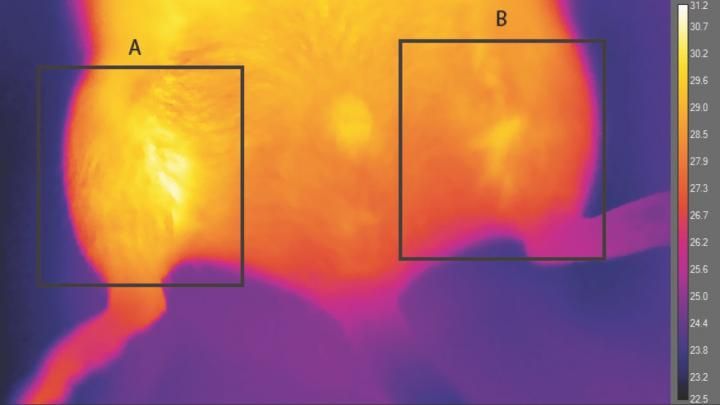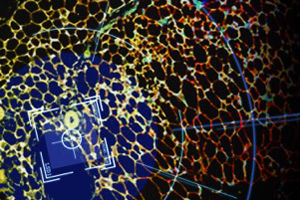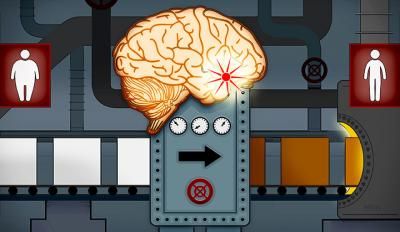Engineered hot fat implants reduce weight gain in mice
Advertisement
Scientists at the University of California, Berkeley, have developed a novel way to engineer the growth and expansion of energy-burning "good" fat, and then found that this fat helped reduce weight gain and lower blood glucose levels in mice.

This is a thermograph of brown-like fat implanted in anesthetized animal at room temperature. Implant, in area A, is significantly warmer (30.86° C maximum) compared with control region in area B (29.43° C maximum)
Kevin Tharp and Andreas Stahl
The authors of the study in the journal Diabetes said their technique could eventually lead to new approaches to combat obesity, diabetes and other metabolic disorders.
The researchers used a specifically tailored hydrogel to "scaffold" and control an implant containing stem cells to form a functional brown-fat-like tissue. While white fat - the kind associated with obesity - stores excess energy, brown fat serves as a heat generator, burning calories as it does its job.
"What is truly exciting about this system is its potential to provide plentiful supplies of brown fat for therapeutic purposes," said study lead author Kevin Tharp, a Ph.D. student in the Department of Nutritional Sciences and Toxicology. "The implant is made from the stem cells that reside in white fat, which could be made from tissue obtained through liposuction."
"This is figuratively and literally a hot area of research right now," said the study's senior author, Andreas Stahl, an associate professor of nutritional sciences and toxicology. "We are the first to implant in mice an artificial brown-fat depot and show that it has the expected effects on body temperature and beneficial effects on metabolism."
Get the fat, not the cold
There are three basic types of fat tissue in our bodies. There is the classic, energy-storing white fat that many of us are most familiar with, and two kinds of energy-burning fat used to generate heat, namely brown fat, which arises during fetal development, and beige fat, which is brown-like fat formed within white fat tissue after exposure to cold and other situations.
This UC Berkeley experiment explored the idea of increasing brown-like beige fat without the temperature drop. Stahl teamed up with Kevin Healy, UC Berkeley professor of bioengineering, and postdoctoral researcher Amit Jha to develop a system of physical cues to guide stem cell differentiation.
Injected brown fat reduces weight gain, glucose
The researchers created a tightly knit 3D mesh in a hydrogel containing water, hyaluronic acid and short protein sequences associated with brown-fat growth and function. They then took white-fat stem cells from mice genetically engineered to express an enzyme from fireflies. This made the cells luminescent, allowing the researchers to track them more easily.
The gel polymerizes after injection and completes its transformation in the animal. The researchers monitored the glowing cells after injection to determine how well they stayed put, how long they persisted in the body and whether they were metabolically functional.
They noticed an increase in the core body temperature of the mice at ambient temperatures of 21 degrees Celsius and after 24 hours at a chilly 4 degrees Celsius. In both cases, the mice with the implanted cells were up to half a degree Celsius warmer than a control group of mice with no injection. The higher the concentration of cells, the larger the effect on temperature.
The researchers also put the experimental mice on a high-fat diet. By the end of three weeks, the mice with injected beige fat gained half as much weight and had lower levels of blood glucose and circulating fatty acids compared with control mice.
























































